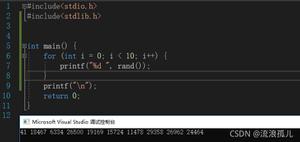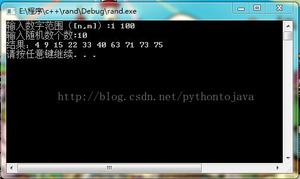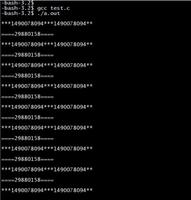python机器学习库numpy---7.2、生成随机数-正态分布

python机器学习" title="python机器学习">python机器学习库numpy---7.2、生成随机数-正态分布
一、总结
一句话总结:
正态分布主要两个函数,一个randn方法,表示标准正态分布,一个是normal方法,表示指定均值和标准差的正态分布
a、标准正态分布(均值为0,标准差为1):numpy.random.randn(d0, d1, ..., dn)
b、服从μ=loc,σ=scale 的正态分布:
numpy.random.normal(loc=0.0, scale=1.0, size=None)
二、7.2、生成随机数-正态分布
博客对应课程的视频位置:7.2、生成随机数-正态分布-范仁义-读书编程笔记
https://www.fanrenyi.com/video/38/348
7、生成随机数
(1)、均匀分布
a、服从[0, 1)之间的均匀分布:numpy.random.rand(d0, d1, ..., dn)
b、[0, 1)之间均匀抽样:
numpy.random.random(size=None)
和rand函数功能一样,参数不同而已
c、在区间[low, high)中均匀分布:
numpy.random.uniform(low=0.0, high=1.0, size=None)
d、随机整数:在区间[low, high)中离散均匀抽样:
numpy.random.randint(low, high=None, size=None, dtype=\'l\')
python中,random.random( )和random.rand( )功能完全一样,numpy为什么要留两个表示0-1均匀分布的函数?
历史原因,可能是为了使 Matlab 用户更容易学习 python+numpy 的组合。如果把其中一个函数去掉,所带来的麻烦远大于好处,因为有很多现存的代码分别使用了这两个函数。
(2)、正态分布
a、标准正态分布(均值为0,标准差为1):numpy.random.randn(d0, d1, ..., dn)
b、服从μ=loc,σ=scale 的正态分布:
numpy.random.normal(loc=0.0, scale=1.0, size=None)
(3)、随机种子
RandomState:定义种子类:RandomState是一个种子类,提供了各种种子方法,最常用seed
seed([seed]):定义全局种子:参数为整数或者矩阵
代码示例:
np.random.seed(1234) #设置随机种子为1234(1)、均匀分布
(a)、服从[0, 1)之间的均匀分布:numpy.random.rand(d0, d1, ..., dn)
作用:
产生一个给定形状的数组(其实应该是ndarray对象或者是一个单值),数组中的值服从[0, 1)之间的均匀分布。参数:
d0, d, ..., dn : int,可选。如果没有参数则返回一个float型的随机数,该随机数服从[0, 1)之间的均匀分布。返回值:
ndarray对象或者一个float型的值In [2]:
import numpy as npprint(np.random.rand())
0.5453255015277448
In [3]:
print(np.random.rand(3))
[0.90757678 0.03145185 0.95313326]
In [4]:
print(np.random.rand(3,4))
[[0.97597192 0.28732266 0.17960605 0.85840045][0.8457097 0.11786519 0.59764586 0.5142609 ]
[0.68330079 0.44224353 0.36096329 0.32893185]]
In [5]:
import matplotlib.pyplot as plt # 导入matplotlib模块,用于图表辅助分析%matplotlib inline
# 解决中文乱码
plt.rcParams["font.sans-serif"]=["SimHei"]
plt.rcParams["font.family"]="sans-serif"
# 解决负号无法显示的问题
plt.rcParams[\'axes.unicode_minus\'] =False
data_x = np.random.rand(1000)
data_y = np.random.rand(1000)
plt.scatter(data_x,data_y)
Out[5]:
<matplotlib.collections.PathCollection at 0x21cf86ec448>
(b)、[0, 1)之间均匀抽样:numpy.random.random(size=None)
作用:
返回从[0, 1)之间均匀抽样的数组,size指定形状。参数:
size:
int型或int型的元组,如果不提供则返回一个服从该分布的随机数返回值:
float型或者float型的ndarray对象In [6]:
# 无参数print(np.random.random())
0.25733366399724056
In [8]:
print(np.random.random(size=(3,)))
[0.87588153 0.41083416 0.92811127]
In [9]:
# 元组做参数print(np.random.random((4,3)))
[[0.03027158 0.09068682 0.08516664][0.88818931 0.7542361 0.97077598]
[0.58459742 0.66082839 0.51209488]
[0.52616617 0.99295998 0.9026425 ]]
In [10]:
import matplotlib.pyplot as plt # 导入matplotlib模块,用于图表辅助分析%matplotlib inline
# 解决中文乱码
plt.rcParams["font.sans-serif"]=["SimHei"]
plt.rcParams["font.family"]="sans-serif"
# 解决负号无法显示的问题
plt.rcParams[\'axes.unicode_minus\'] =False
data_x = np.random.random((1000,))
data_y = np.random.random((1000,))
plt.scatter(data_x,data_y)
Out[10]:
<matplotlib.collections.PathCollection at 0x21cf877de88>
(c)、在区间[low, high)中均匀分布:numpy.random.uniform(low=0.0, high=1.0, size=None)
作用:
返回一个在区间[low, high)中均匀分布的数组,size指定形状。参数:
low, high:float型或者float型的类数组对象。指定抽样区间为[low, high),low的默认值为0.0,hign的默认值为1.0size:
int型或int型元组。指定形状,如果不提供size,则返回一个服从该分布的随机数。In [11]:
print(np.random.uniform())
0.8464163023853011
In [12]:
print(np.random.uniform(10,100,(4,5)))
[[86.86036611 82.50530283 51.3847694 14.54433224 85.78924098][88.45675899 80.67287362 88.57930721 79.2433418 95.33601246]
[97.38877669 97.10142936 75.48331286 47.14349932 50.931656 ]
[57.54116023 34.31330871 39.62217741 79.27942515 34.2372894 ]]
In [13]:
import matplotlib.pyplot as plt # 导入matplotlib模块,用于图表辅助分析%matplotlib inline
# 解决中文乱码
plt.rcParams["font.sans-serif"]=["SimHei"]
plt.rcParams["font.family"]="sans-serif"
# 解决负号无法显示的问题
plt.rcParams[\'axes.unicode_minus\'] =False
data_x = np.random.uniform(10,100,(1000,))
data_y = np.random.uniform(10,100,(1000,))
plt.scatter(data_x,data_y)
Out[13]:
<matplotlib.collections.PathCollection at 0x21cf8812ac8>
(d)、随机整数:在区间[low, high)中离散均匀抽样:numpy.random.randint(low, high=None, size=None, dtype=\'l\')
作用:
返回一个在区间[low, high)中离散均匀抽样的数组,size指定形状,dtype指定数据类型。参数:
low, high:int型,指定抽样区间[low, high)size:int型或int型的元组,指定形状
dypte:可选参数,指定数据类型,比如int,int64等,默认是np.int
返回值:
如果指定了size,则返回一个int型的ndarray对象,否则返回一个服从该分布的int型随机数。In [16]:
print(np.random.randint(10))
7
In [ ]:
# 只有一个参数的时候表示最大值print(np.random.randint(10))
In [17]:
help(np.random.randint)
Help on built-in function randint:randint(...) method of numpy.random.mtrand.RandomState instance
randint(low, high=None, size=None, dtype=\'l\')
Return random integers from `low` (inclusive) to `high` (exclusive).
Return random integers from the "discrete uniform" distribution of
the specified dtype in the "half-open" interval [`low`, `high`). If
`high` is None (the default), then results are from [0, `low`).
.. note::
New code should use the ``integers`` method of a ``default_rng()``
instance instead; see `random-quick-start`.
Parameters
----------
low : int or array-like of ints
Lowest (signed) integers to be drawn from the distribution (unless
``high=None``, in which case this parameter is one above the
*highest* such integer).
high : int or array-like of ints, optional
If provided, one above the largest (signed) integer to be drawn
from the distribution (see above for behavior if ``high=None``).
If array-like, must contain integer values
size : int or tuple of ints, optional
Output shape. If the given shape is, e.g., ``(m, n, k)``, then
``m * n * k`` samples are drawn. Default is None, in which case a
single value is returned.
dtype : dtype, optional
Desired dtype of the result. All dtypes are determined by their
name, i.e., \'int64\', \'int\', etc, so byteorder is not available
and a specific precision may have different C types depending
on the platform. The default value is `np.int_`.
.. versionadded:: 1.11.0
Returns
-------
out : int or ndarray of ints
`size`-shaped array of random integers from the appropriate
distribution, or a single such random int if `size` not provided.
See Also
--------
random_integers : similar to `randint`, only for the closed
interval [`low`, `high`], and 1 is the lowest value if `high` is
omitted.
Generator.integers: which should be used for new code.
Examples
--------
>>> np.random.randint(2, size=10)
array([1, 0, 0, 0, 1, 1, 0, 0, 1, 0]) # random
>>> np.random.randint(1, size=10)
array([0, 0, 0, 0, 0, 0, 0, 0, 0, 0])
Generate a 2 x 4 array of ints between 0 and 4, inclusive:
>>> np.random.randint(5, size=(2, 4))
array([[4, 0, 2, 1], # random
[3, 2, 2, 0]])
Generate a 1 x 3 array with 3 different upper bounds
>>> np.random.randint(1, [3, 5, 10])
array([2, 2, 9]) # random
Generate a 1 by 3 array with 3 different lower bounds
>>> np.random.randint([1, 5, 7], 10)
array([9, 8, 7]) # random
Generate a 2 by 4 array using broadcasting with dtype of uint8
>>> np.random.randint([1, 3, 5, 7], [[10], [20]], dtype=np.uint8)
array([[ 8, 6, 9, 7], # random
[ 1, 16, 9, 12]], dtype=uint8)
In [20]:
print(np.random.randint(low=10,size=(3,4),high=100))
[[60 19 81 87][49 67 85 46]
[69 25 92 44]]
In [21]:
import matplotlib.pyplot as plt # 导入matplotlib模块,用于图表辅助分析%matplotlib inline
# 解决中文乱码
plt.rcParams["font.sans-serif"]=["SimHei"]
plt.rcParams["font.family"]="sans-serif"
# 解决负号无法显示的问题
plt.rcParams[\'axes.unicode_minus\'] =False
data_x = np.random.randint(10,100,(1000,))
data_y = np.random.randint(10,100,(1000,))
plt.scatter(data_x,data_y)
Out[21]:
<matplotlib.collections.PathCollection at 0x21cf8922348>
(2)、正态分布
(a)、标准正态分布(均值为0,标准差为1):numpy.random.randn(d0, d1, ..., dn)
作用:
返回一个指定形状的数组,数组中的值服从标准正态分布(均值为0,标准差为1)。参数:
d0, d, ..., dn : int,可选。如果没有参数,则返回一个服从标准正态分布的float型随机数。返回值:
ndarray对象或者floatIn [5]:
# 无参数import numpy as np
print(np.random.randn())
0.13376456884878418
In [6]:
print(np.random.randn(3))
[ 0.00692413 1.7347139 -0.98832561]
In [7]:
# 3行4列 的正态分布print(np.random.randn(3,4))
# 正态分布,所以我们可以看到结果有正有负
[[ 0.46288376 -0.9402719 -1.3791829 0.12095743][ 1.47022746 -0.77955805 -0.38801507 0.52498791]
[ 0.12182416 1.74959633 1.20357299 -1.10387593]]
In [8]:
import matplotlib.pyplot as plt # 导入matplotlib模块,用于图表辅助分析%matplotlib inline
# 解决中文乱码
plt.rcParams["font.sans-serif"]=["SimHei"]
plt.rcParams["font.family"]="sans-serif"
# 解决负号无法显示的问题
plt.rcParams[\'axes.unicode_minus\'] =False
data_x = np.random.randn(1000)
data_y = np.random.randn(1000)
plt.scatter(data_x,data_y)
Out[8]:
<matplotlib.collections.PathCollection at 0x264250a59c8>
(b)、服从μ=loc,σ=scale 的正态分布:numpy.random.normal(loc=0.0, scale=1.0, size=None)
作用:
返回一个由size指定形状的数组,数组中的值服从 μ=loc,σ=scale 的正态分布。参数:
loc : float型或者float型的类数组对象,指定均值 μscale : float型或者float型的类数组对象,指定标准差 σ
size : int型或者int型的元组,指定了数组的形状。如果不提供size,且loc和scale为标量(不是类数组对象),则返回一个服从该分布的随机数。
输出:
ndarray对象或者一个标量In [9]:
# 无参数print(np.random.normal())
1.3048521009886291
In [10]:
# 3行4列 的正态分布print(np.random.normal(10,2,(3,4)))
[[ 6.64607268 14.28870815 11.04433027 12.77813207][ 8.38923977 11.63867271 11.28538438 12.20541604]
[10.08465579 8.88528815 12.41447794 7.58024792]]
In [11]:
import matplotlib.pyplot as plt # 导入matplotlib模块,用于图表辅助分析%matplotlib inline
# 解决中文乱码
plt.rcParams["font.sans-serif"]=["SimHei"]
plt.rcParams["font.family"]="sans-serif"
# 解决负号无法显示的问题
plt.rcParams[\'axes.unicode_minus\'] =False
data_x = np.random.normal(10,2,(1000))
data_y = np.random.normal(10,2,(1000))
plt.scatter(data_x,data_y)
Out[11]:
<matplotlib.collections.PathCollection at 0x26425174688>
(3)、随机种子
计算机实现的随机数生成通常为伪随机数生成器,为了使得具备随机性的代码最终的结果可复现,需要设置相同的种子值
电脑产生随机数需要明白以下几点:
(1)随机数是由随机种子根据一定的计算方法计算出来的数值。所以,只要计算方法一定,随机种子一定,那么产生的随机数就不会变。 (2)只要用户不设置随机种子,那么在默认情况下随机种子来自系统时钟(即定时/计数器的值)
(3)随机数产生的算法与系统有关,Windows和Linux是不同的,也就是说,即便是随机种子一样,不同系统产生的随机数也不一样。
随机种子方法
RandomState:定义种子类:RandomState是一个种子类,提供了各种种子方法,最常用seed
seed([seed]):定义全局种子:参数为整数或者矩阵
代码示例:
np.random.seed(1234) #设置随机种子为1234
In [3]:
#1为种子,种子不一样,生成的随机数也不一样,但是对每个种子来说,每次运行所生成的随机数是相同的import numpy as np
rs = np.random.RandomState(1)
data = rs.rand(30)
print(data)
[4.17022005e-01 7.20324493e-01 1.14374817e-04 3.02332573e-011.46755891e-01 9.23385948e-02 1.86260211e-01 3.45560727e-01
3.96767474e-01 5.38816734e-01 4.19194514e-01 6.85219500e-01
2.04452250e-01 8.78117436e-01 2.73875932e-02 6.70467510e-01
4.17304802e-01 5.58689828e-01 1.40386939e-01 1.98101489e-01
8.00744569e-01 9.68261576e-01 3.13424178e-01 6.92322616e-01
8.76389152e-01 8.94606664e-01 8.50442114e-02 3.90547832e-02
1.69830420e-01 8.78142503e-01]
In [3]:
# 如果没设置随机数import numpy as np
print(np.random.rand(30))
[0.91197644 0.6504751 0.54849346 0.1408817 0.79662447 0.76571730.88059378 0.28970806 0.04421655 0.8258623 0.77949267 0.21584071
0.54239107 0.84065671 0.98545231 0.93971736 0.94389124 0.4268576
0.24076141 0.79165343 0.35609388 0.29818106 0.0966155 0.27966646
0.11785404 0.485944 0.89728192 0.25347008 0.81296457 0.63926957]
In [4]:
import numpy as npnp.random.seed(1) #设置随机种子为1
print(np.random.rand(30))
[4.17022005e-01 7.20324493e-01 1.14374817e-04 3.02332573e-011.46755891e-01 9.23385948e-02 1.86260211e-01 3.45560727e-01
3.96767474e-01 5.38816734e-01 4.19194514e-01 6.85219500e-01
2.04452250e-01 8.78117436e-01 2.73875932e-02 6.70467510e-01
4.17304802e-01 5.58689828e-01 1.40386939e-01 1.98101489e-01
8.00744569e-01 9.68261576e-01 3.13424178e-01 6.92322616e-01
8.76389152e-01 8.94606664e-01 8.50442114e-02 3.90547832e-02
1.69830420e-01 8.78142503e-01]
In [ ]:
以上是 python机器学习库numpy---7.2、生成随机数-正态分布 的全部内容, 来源链接: utcz.com/z/389509.html









